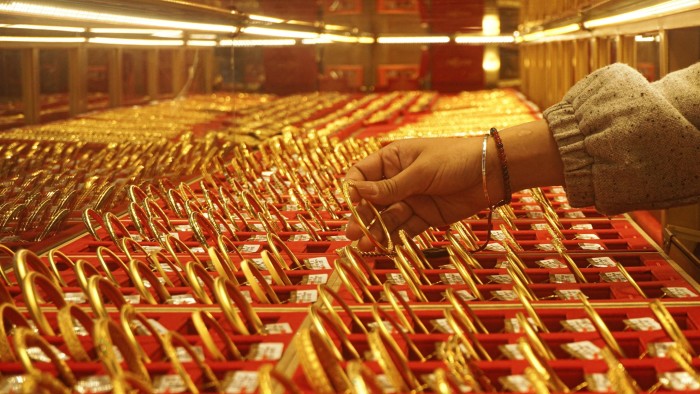Unlock the Editor’s Digest for free
Roula Khalaf, Editor of the FT, selects her favourite stories in this weekly newsletter.
Chinese investors are piling into gold funds at a record rate, as Donald Trump’s trade war and fears over a US recession and inflation drive a hunt for haven assets.
Inflows into gold exchange traded funds in China total 70 tonnes — or about $7.4bn — so far this month, more than double the previous monthly record, according to the World Gold Council, an industry body.
“Whilst we have seen ETF demand from other regions, China is really in the lead now,” said John Reade, senior market strategist at the WGC, adding that Chinese investment demand for the precious metal had risen “dramatically” this month.
The country’s share of global gold ETF holdings has jumped to 6 per cent, up from 3 per cent at the start of this year, while over the past four weeks Chinese demand accounted for more than half of global gold ETF inflows.
Gold has been one of the best-performing assets since the election of the US president late last year, with many other popular “Trump trades” such as the dollar, bitcoin or stocks making big early gains before reversing course.
The yellow metal has repeatedly surged to fresh highs, and rose above $3,500 per troy ounce last week before falling back to about $3,300. Since the end of last year it has gained 26 per cent.
Last week the local price premium for gold in China briefly rose to $100 per troy ounce above the international US dollar gold price, in a sign of huge local demand.
The buying frenzy, even as prices surge, has prompted the Shanghai Gold Exchange to issue warnings.
“Investors should manage risks and make rational investment decisions in light of recent gold price fluctuations,” it said in a statement last week.
The country’s tight capital controls mean that investors there have limited investment options. With the real estate market in crisis and the stock market down sharply in recent years, gold has become an attractive alternative for many investors.
Retail investors in mainland China are now approaching gold much like they do stocks, according to a Shanghai-based client manager at a mid-sized brokerage. “It’s just like when stocks rise and mom-and-pop investors rush to open securities accounts,” he said. “With gold prices soaring, people think buying gold is a sure way to make money.”
China is the world’s biggest buyer of gold bars and coins, and second-biggest buyer of gold jewellery after India, but the growth of gold-backed ETFs in the country has been limited until recently.

Total global demand for gold — taking into account all forms of buying — climbed to 1,206 tonnes during the first quarter of the year, up 1 per cent compared with the same period a year prior, according to the WGC quarterly report released on Wednesday.
Jewellery demand fell 21 per cent during the quarter compared with a year ago as buyers shied away from higher prices. But global investment demand for gold, which includes gold bars and coins as well as investments in ETFs, rose 170 per cent over the same period last year.
That has prompted the WGC to raise its forecast for gold investment demand this year — which it publishes as a range of outcomes — by about 160 tonnes at the midpoint, compared with its previous forecast at the end of 2024.
“What we hadn’t anticipated was the flurry of policy pronouncements out of the White House, the going so hard on tariffs, the executive orders. All of this has materially raised uncertainty in markets and triggered an investor demand for gold that we were not anticipating,” said Reade.
A huge stockpile of gold built up in New York during the first quarter of this year, leading to a shortage in London, as traders rushed to bring in supplies ahead of the potential imposition of tariffs.
However, now that the White House has said that tariffs will not apply to bullion, that flow is reversing and the gold inventories are starting to be drawn down.
https://www.ft.com/content/08d91dc3-2c4b-4281-8a3c-55350ee550f8


